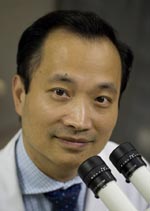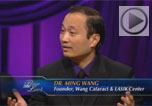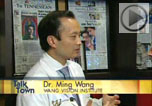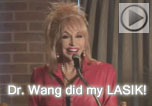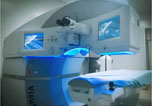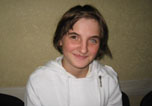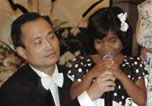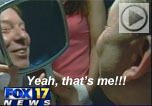- Over 55,000 LASIK and cataract procedures (including on over 4,000 doctors)
- The FIRST center in TN to offer Laser Cataract Surgery
- Introduced bladeless all-laser LASIK to the state
- Implanted the state's first FOREVER YOUNG™ Lens
- The first surgeons in the US to perform a new Intacs surgery to treat keratoconus
- Helped patients from 40 states and 55 countries
- International referral center for cataract surgery and LASIK complications
- Read Dr. Wang's book: LASIK Vision Correction
Why did you decide to have LASIK? Why did you choose Dr. Wang? How has your life changed since your LASIK procedure?
What is your advice for people considering LASIK?
Click to read more
| Article Library | Print This Page |
“Nonprofit foundation gives poor the gift of sight” – Tennessean article “Tennessee Voice”
TENNESSEE VOICES, Tennessean.com, 12/23/11.
Nonprofit foundation gives poor the gift of sight
By Ming Wang, MD, PhD
America is experiencing an unprecedented financial crisis. We need to provide adequate healthcare for all our citizens, especially the poor, but we seem to have no way to pay for it. More government control and higher taxes are clearly not good solutions, but what is?
Because the holiday season is a time of giving, I am reminded once again that charity and volunteerism are still our best solutions. In every field of medicine, there are professional medical societies that accept charitable donations (many that are tax-deductible) and welcome volunteers, such as American Heart Association, American Diabetes Association and American Red Cross. In this article, I would like to share some experiences over the past 8 years with our sight restoration foundation.
In 2003, we founded the 501(c)3 non-profit sight foundation to help indigent patients undergo advanced sight restoration surgeries free-of-charge. We felt that a physician- and civilian-organized, grassroots effort is our best option in helping to provide medical care (in this case, eye care) for the poor, while at the same time avoiding more governmental control and bureaucracy. The premise of our foundation is very simple: Many people, including doctors, do want to help but they need to know how to help; and therefore, a structure was needed to make it possible for them to be able to volunteer and contribute. People have different ways of helping depending on their own specific areas of knowledge, expertise and available resources, so the key here is to creatively build this structure--an organization with vision (no pun intended)--so that the doctors can productively be engaged and united to channel their energies and resources toward the common goal of providing free medical care for the poor, and in doing so, reduce the financial burden on our nation’s healthcare.
Our foundation’s efforts consist of three parts:
- Recruit a group of physicians who are committed to providing free medical care to indigent foundation patients.
- Enlist the help of pharmaceutical and medical instrument companies who are willing to support this effort by providing free medical supplies.
- Organize a board of philanthropically-minded civilians who are not only committed to supporting and donating to the foundation themselves, but who are also willing to reach out via their social circles of influence to engage and involve the society-at-large, for the cause of sight restoration for the poor.
To date, we have recruited 23 eye doctors into the foundation’s medical council, all whom are committed to providing free medical care to foundation patients triaged to them in their respective areas of specialty. Approximately a dozen medical instrument and drug companies have been enlisted as well, and have provided consistent support to the foundation over the years. In addition, we have built a solid and well-respected board of directors for the foundation, consisting of 29 community and business leaders and philanthropists, all who have supported and contributed to the foundation, and have also reached out to a larger segment of society to encourage them to get involved with the foundation’s efforts.
Each year, the foundation organizes an annual gala--the EyeBall--which utilizes the excitement and beauty of classical ballroom dance and music to bring people together from all parts of society, in order to experience the beauty that sight allows, to meet blind patients who truly need help so they can eventually experience this beauty as well, to feel a renewed appreciation of the God-given gift of sight, and to realize how much we need to help those who have lost it. The foundation has also funded research for new sight restoration technologies, and its doctors published a paper in the world renowned journal “Nature” and 6 textbooks. They hold several US patents for inventions of new biotechnologies to restore sight, and they performed the world’s first laser-assisted artificial cornea implantation. To date, the foundation has helped patients from over 40 states in the US and 55 countries worldwide, with all sight restoration surgeries performed free-of-charge.
In summary, charitable giving and volunteer medical care, when creatively envisioned and properly organized, can truly make a difference. As we have experienced with our foundation, such a grassroots civilian- and physician-organized effort can effectively help provide free medical care for those who need it the most, yet are the least able to pay for it. In the process, it can also help to reduce the financial burden of our nation’s healthcare system.
Ming Wang, MD, PhD is the founder and chairman of Wang Foundation for Sight Restoration, clinical associate professor of ophthalmology for the University of Tennessee, and director of Wang Vision 3D Cataract & LASIK Center. He can be reached at drwang@wangvisioninstitute.com and www.wangfoundation.com.
Our new texbooks
A 501c(3) charity that has helped patients from over 40 states in the US and 55 countries, with all sight restoration surgeries performed free-of-charge.


